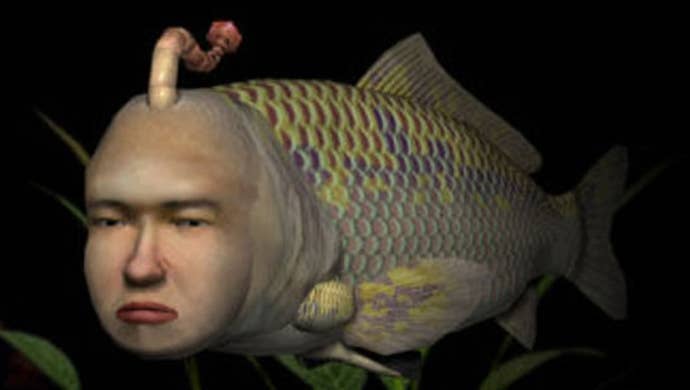Yoot Saito and Kenichi Nishi: Two Japanese Indie Veterans Are Back to Making Games
Yoot Saito and Kenichi Nishi have been independent longer than pretty much anyone else, and both have new projects underway.
This article first appeared on USgamer, a partner publication of VG247. Some content, such as this article, has been migrated to VG247 for posterity after USgamer's closure - but it has not been edited or further vetted by the VG247 team.
Yutaka "Yoot" Saito pretty neatly sums up why he's been an independent developer all these years: "For me, it's very difficult to not be independent. I'm not very good at teamwork."
Saito, who is best-known for his work on SimTower and the Dreamcast's peculiar Seaman, was at BitSummit to scout the Japanese indie community. Saito's last game was the 2012 sim Aero Porter, which was released as part of Level-5's Guild01 compilation. After that, he spent the next few years prototyping globe apps that depict things like the rise and fall of the British Empire over the period of 150 years. Now he's back to game development, and in his characteristically blunt way, he explains why.

"To be honest? We needed money," Saito says.
Saito isn't the only veteran indie working on a new game. Kenichi Nishi, the former Chrono Trigger and Super Mario RPG developer, also revealed that he's working on a game called Lunatan - a digging action puzzle game for smartphone. Saito, for his part, is working on a project he's codenamed Gold Rush, where players mine gold and turn it into a kind of virtual currency that can be used across several games that Saito is planning.
Both Saito and Nishi are pioneers of a sort in the Japanese independent developer space. Saito has been independent pretty much since developing SimTower (then known as "The Tower") back in the early '90s. Nishi, for his part, left Squaresoft in 1995 out of a desire to make his own games. Both are known for their creativity, with Nishi being responsible for Chibi Robo and the odd action-adventure game Captain Rainbow, and Saito working on a pinball game set in feudal Japan called Odama (as it happens, Nintendo wound up publishing both Captain Rainbow and Odama).

Nishi is the more traditional of the two, his work over the years bearing a resemblance to the kind of indie games you might find on Steam or elsewhere. Saito, on the other hand, strikes me as more of a tinkerer. Seaman, which is perhaps his best-known work, was born out of his desire to work with voice recognition technology. When he got into game development, it was on the Macintosh - a platform that was practically unknown in Japan back in the early '90s. He loves nothing more than to sit around and prototype new ideas.
Their respective games, though both on what one might call a "casual" platform in the smartphone, bear that out. Nishi's game has a whimsical look to it, with art that wouldn't look out of place in a mid-90s Super Famicom game. Saito, meanwhile, seems to be trying to model something like a Bitcoin simulator (he actually mentions Bitcoin when talking about the game). It's not the easiest idea to wrap your head around, but it feels in keeping with his previous track record.
It's easy to wonder whether the two have moved to smartphone out of necessity. Up until recently, Saito was even what you might call hostile to the platform. "Before smartphones came out, I didn't like mobile games, because the graphics weren't good and they were kind of static. The quality wasn't good enough, and it made money by charging people. Twenty percent of sales came from people who forgot to cancel sales, so I didn't think that was fair. After smartphones came out, I was still anxious about what to do. I loved the Macintosh, I wrote a lot of books about Apple; but when the smartphone came out, I didn't like it so much. So I stayed out."

Things change, though. Saito's attitude seems to have softened now that the platform has become entrenched and he's spent some time prototyping his globe apps for it. Plus, it affords him the flexibility to build the mini-virtual economy he has planned.
Nishi, for his part, says he went to smartphone because he was asked if he had any good ideas for the platform. He has an optimistic view of current trends. "I've seen veterans, amateurs, students, all making games, and they're all on the same level ground. I think that's great."
As Saito and Nishi kickoff their new games, they find themselves in the midst of a rapidly growing indie scene. In a sense, the teachers have become the students as they've had to adjust to current trends and try to learn from the younger generation. Things are moving so fast that experience doesn't necessarily count for much.
In talking about how things have changed since the '90s, Nishi says, "What has changed is that the indie industry has gotten recognition from Japan at large."
He later adds, "I've seen veterans, amateurs, students, all making games, and they're all on the same level ground. I think that's great."
As for Saito, he sees himself as something akin to Mickey Rourke's character in The Wrestler - an old veteran trying to get back in the game and learn from the younger set.
"I'm 53 going on 54. I don't know much," he says. "I will get answers tonight, maybe in the bar."









